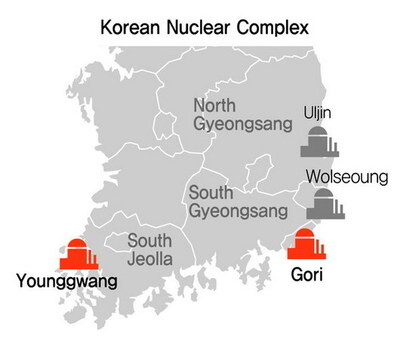hankyoreh
Links to other country sites 다른 나라 사이트 링크
Study calls for surcharge to support residents near nuclear power plants

By Kim Kwang-soo, Busan correspondent
A recent study is drawing attention with calls for a new system requiring residents of areas far away from nuclear power plants to pay an additional usage fee beyond their utility costs in order to provide for safety measures for people living in the power plant regions.
The paper, titled “An Empirical Analysis of the Introduction of a Nuclear Power Plant Safety Usage Surcharge for the Decommissioning of the Kori Nuclear Power Plant,” was recently published in the journal of the Korea Association for Local Government Studies by professors Kim Hae-chang (Kyungsung University), Kim Young-ha (Dong-A University), and Cha Jae-kwon (Dong-Eui University).
In it, the professors argued for a new surcharge “to benefit residents and local governments in regions with nuclear power plants that would suffer direct damages in the event of an accident.”
The idea is to collect the surcharges from residents and businesses in areas far away from the plants, with higher rates applied at farther distances. The money would then be used to compensate for economic damages, cover accident prevention and disaster response costs, and support a long-term post-nuclear power energy fund for the Emergency Planning Zones (EPZs) that would have to evacuate and/or take precautionary actions for exposure to radiation if an accident occurs.
An EPZ is defined as the area within a 30 km radius of a nuclear power plant.
Korea Hydro and Nuclear Power (KHNP), which operates South Korea’s nuclear plants, currently provides a subsidy to residents within 5 km of the facilities for village development funds and other purposes. Those living between 5 and 30 km away do not receive benefits.
But when the Fukushima disaster occurred in 2011, the Japanese government issued evacuation or stay-inside-the-home orders for all residents within a 30-km radius of the accident.
In South Korea, there are 3.5 million people living within a 30 km radius of the Kori Nuclear Power Plant in Gijang County, Busan; another 1.33 million in the case of Wolseong Nuclear Power Plant in Gyeongju, North Gyeongsang Province; 80,000 for Hanul Nuclear Power Plant in Uljin, North Gyeongsang; and 150,000 for Hanbit Nuclear Power Plant in Yeonggwang, South Jeolla Province.
For the study, the researchers questioned 1,000 randomly selected Seoul residents over 20 on May 9-11 and May 16-18 on what sort of surcharge they would be able to pay. The response came out to an average of 4,556 won (US$4.31) per month. With a total of 4,969,894 taxpayers living in Seoul, revenues from the surcharge there could amount to 22.6 billion won (US$21.4 million) a month, or 271.7 billion won (US$257.1 million) a year.
The total would be 6.2 times the 44 billion won (US$41.6 million) provided in subsidies to Gijang County and its residents in 2002 by Kori Nuclear Power Plant in accordance with the Nuclear Power Plant Environs Support Act.
“The power plant safety surcharge operates on the same principle as the water surcharge system, where downstream water users have been paying a surcharge since 1999 for the sake of upstream supply source residents who bear the brunt of protected zone regulations,” the researchers explained.
“Such a system needs to be introduced for the sake of regional decentralization of energy authority,” they added.
In Japan, thirteen cities and prefectures that have nuclear power plants have been collecting charges of 10% to 13% of nuclear fuel prices from nuclear power plant operators since 1976 to provide for nuclear power safety and environmental protection measures.
Please direct questions or comments to [english@hani.co.kr]

Editorial・opinion
![[Column] Park Geun-hye déjà vu in Yoon Suk-yeol [Column] Park Geun-hye déjà vu in Yoon Suk-yeol](https://flexible.img.hani.co.kr/flexible/normal/500/300/imgdb/original/2024/0424/651713945113788.jpg) [Column] Park Geun-hye déjà vu in Yoon Suk-yeol
[Column] Park Geun-hye déjà vu in Yoon Suk-yeol![[Editorial] New weight of N. Korea’s nuclear threats makes dialogue all the more urgent [Editorial] New weight of N. Korea’s nuclear threats makes dialogue all the more urgent](https://flexible.img.hani.co.kr/flexible/normal/500/300/imgdb/original/2024/0424/7317139454662664.jpg) [Editorial] New weight of N. Korea’s nuclear threats makes dialogue all the more urgent
[Editorial] New weight of N. Korea’s nuclear threats makes dialogue all the more urgent- [Guest essay] The real reason Korea’s new right wants to dub Rhee a founding father
- [Column] ‘Choson’: Is it time we start referring to N. Korea in its own terms?
- [Editorial] Japan’s rewriting of history with Korea has gone too far
- [Column] The president’s questionable capacity for dialogue
- [Column] Are chaebol firms just pizza pies for families to divvy up as they please?
- [Column] Has Korea, too, crossed the Rubicon on China?
- [Correspondent’s column] In Japan’s alliance with US, echoes of its past alliances with UK
- [Editorial] Does Yoon think the Korean public is wrong?
Most viewed articles
- 1‘We must say no’: Seoul defense chief on Korean, USFK involvement in hypothetical Taiwan crisis
- 2N. Korean delegation’s trip to Iran shows how Pyongyang is leveraging ties with Moscow
- 346% of cases of violence against women in Korea perpetrated by intimate partner, study finds
- 4[Column] Park Geun-hye déjà vu in Yoon Suk-yeol
- 5‘Weddingflation’ breaks the bank for Korean couples-to-be
- 6Will NewJeans end up collateral damage in internal feud at K-pop juggernaut Hybe?
- 7Amnesty notes ‘erosion’ of freedom of expression in Korea in annual human rights report
- 8[Interview] Dear Korean men, It’s OK to admit you’re not always strong
- 9Korean government’s compromise plan for medical reform swiftly rejected by doctors
- 10[Editorial] Japan’s rewriting of history with Korea has gone too far